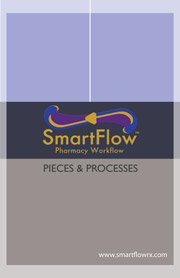
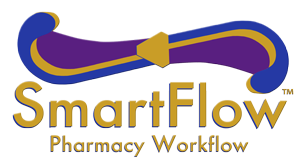
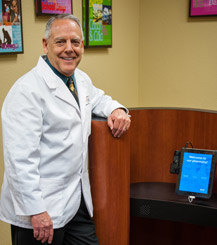
Welcome!
My name is Don Grove. I am a practicing retail pharmacist in a rural town of 2000, Warsaw, MO. We are situated in a 28,000 sq. ft. medical building that we also own and rent to other medical professionals. If you are a retail pharmacy, I would like to help you increase productivity in your store. If you are a vendor, I would like to help you sell more products and services by showing you how you can help independent pharmacies increase their speed, accuracy and employee satisfaction, which will translate into their bottom line and into more sales for you.
I will move around our pharmacy and quickly explain how the SmartFlow pharmacy workflow system works very efficiently for us and could do the same for you. However, you might have to redesign your pharmacy to make room for new work stations and carousels.
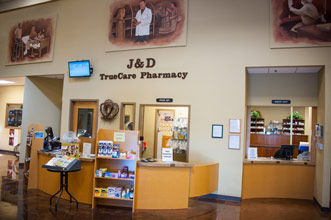 First we have our front end and HME. Notice the way we have removed the fish bowl look that most pharmacies have used for the last 50 years. It was so simple by just making it into a POS bagging area. Next, we have our receiving area and of course we have a drive up window that is accessed from inside the pharmacy. All our areas are paperless due to our scanners. The entry tech at the drop-off station can enter about 600+ a day from walk-in patients, IVR, call-ins, etc. but we do rotate so they don’t get over-stressed as this is the hardest job in the pharmacy.
First we have our front end and HME. Notice the way we have removed the fish bowl look that most pharmacies have used for the last 50 years. It was so simple by just making it into a POS bagging area. Next, we have our receiving area and of course we have a drive up window that is accessed from inside the pharmacy. All our areas are paperless due to our scanners. The entry tech at the drop-off station can enter about 600+ a day from walk-in patients, IVR, call-ins, etc. but we do rotate so they don’t get over-stressed as this is the hardest job in the pharmacy.
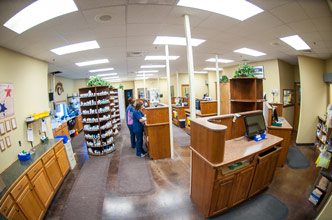 Next we have the technician work stations. The features are covered in the products page in detail but I will point out a few, including the inventory carousels and urgency colored bags. After the technician completes the prescription, it is taken to the pharmacist work station where we have a carousel for the bags by time of entry. Pharmacist retrieves a bag, quickly verifies the accuracy, and sends it on to the OTC clerks, who prepare it for POS.
Next we have the technician work stations. The features are covered in the products page in detail but I will point out a few, including the inventory carousels and urgency colored bags. After the technician completes the prescription, it is taken to the pharmacist work station where we have a carousel for the bags by time of entry. Pharmacist retrieves a bag, quickly verifies the accuracy, and sends it on to the OTC clerks, who prepare it for POS.
There are 2 opportunities to counsel, at the front when dropping off the Rx’s, or as the Rx’s are prepared and OTC clerks may guide the patient to either of our counseling widows. One is semi-private and the other is private. The private window doubles as a lunch counter by pulling down the steel cage door. Our nursing home operation is close and keeps the meds coming all day for verification.
One pharmacist can verify about 300-600 depending whether the pharmacist is a production pharmacist or a clinical pharmacist. Some can do both equally well but we have found most pharmacists fall into one of the 2 categories very naturally, and even the pharmacist seems to know which one he enjoys and is best at.
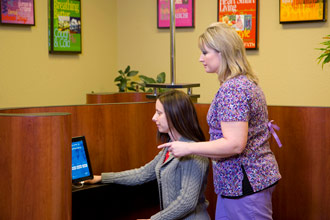 Should the patient want further counseling, it also is available at our education area on eosk iPad stations where they can either view or email videos to themselves or a family member for later viewing. If we have a patient's email address on file, a link is automatically sent when the Rx is filled. These videos cover disease states, medications, and devices such as epi pens, inhalers, eye and ear drops.
Should the patient want further counseling, it also is available at our education area on eosk iPad stations where they can either view or email videos to themselves or a family member for later viewing. If we have a patient's email address on file, a link is automatically sent when the Rx is filled. These videos cover disease states, medications, and devices such as epi pens, inhalers, eye and ear drops.
The work stations cost about $3000 each, but when you figure you might be like us and have technicians filling 170 in one day and pharmacists verifying 5-600 or more, that is a minuscule investment when the accuracy actually increase, as does employee satisfaction. When compared to the NCPA Digest averages of just 55 fills per tech and 128 verified per pharmacist, I find it hard to understand why an owner wouldn’t make the investment. It reminds me of the time in 1974 when I got my first computer and it replaced one pharmacist and one technician and certainly lessened my stress level. Maybe history does repeat itself if you just dare to imagine the impossible!
Get more details Take a video tour or check out the products page!
